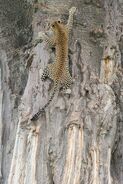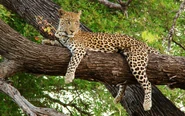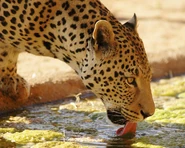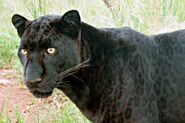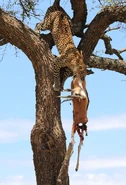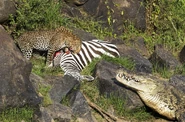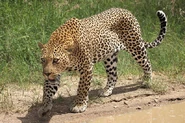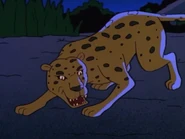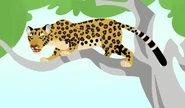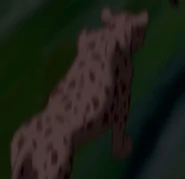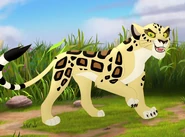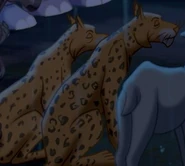
African leopard at Serengeti National Park, Tanzania.
The leopard (Panthera pardus) (pronounced /\ˈle-pərd\/) is one of the five "big cats" in the genus Panthera. It is a member of the family Felidae with a wide range in regions of sub-Saharan Africa, West Asia, the Middle East, South and Southeast Asia to Siberia. Fossil records found in Italy suggest that in the Pleistocene it ranged as far as Europe. Compared to other members of Felidae, the leopard has relatively short legs and a long body with a large skull. It is similar in appearance to the jaguar, but is smaller and more lightly built. Its fur is marked with rosettes similar to those of the jaguar, but the leopard's rosettes are smaller and more densely packed, and do not usually have central spots as the jaguar's do. Both leopards and jaguars that are melanistic are known as black panthers.
The leopard's success in the wild is due to its well camouflaged fur; its opportunistic hunting behaviour, broad diet, and strength to move heavy carcasses into trees; its ability to adapt to various habitats ranging from rainforest to steppe and including arid and montane areas; and to run at speeds up to 58 kilometres per hour (36 mph). It is listed as near threatened on the IUCN Red List because leopard populations are declining in large parts of their range. They are threatened by habitat loss and pest control. Their habitats are fragmented and they are illegally hunted so that their pelts may be sold in wildlife trade for medicinal practices and decoration. They have been extirpated in Hong Kong, Singapore, Kuwait, Syria, Libya, Tunisia and most likely Morocco.
Variant Colouration[]
Melanistic leopards, known, like the melanistic jaguars, as "black panthers". Pseudomelanism (abundism) also occurs in leopards. Melanism in leopards is inherited as a trait relatively recessive to the spotted form. Interbreeding in melanistic leopard produces a significantly smaller litter size than produced by normal pairings.
The black panther is common in the equatorial rainforest of Malaya and the tropical rainforest on the slopes of some African mountains such as Mount Kenya. Between January 1996 and March 2009, Indochinese leopards were photographed at 16 sites in the Malay Peninsula in a sampling effort of more than 1000 trap nights. Of the 445 photographs of melanistic leopards, 410 came from study sites south of the Kra Isthmus, where the non-melanistic morph was never photographed. This data suggests the near fixation of the dark allele in the region. The expected time for the fixation of this recessive allele due to genetic drift alone ranged from about 1,100 years to about 100,000 years.
A rare "strawberry" leopard was photographed in South Africa's Madikwe Game Reserve. This condition was probably caused by erythrism, a little-understood genetic condition that causes either an overproduction of red pigments or an underproduction of dark pigments. Pseudomelanism has also been reported in leopard.
Characteristics[]
The leopard is one of the big cats. Males stand 60–70 cm (24–28 in) at the shoulder; females are 57–64 cm (22–25 in) tall. The head-and-body length is typically between 90–190 cm (35–75 in). While males weigh 37–90 kg (82–198 lb), females weigh 28–60 kg (62–132 lb). The tail is nearly 58–110 cm (23–43 in) long. Leopards show a great diversity in coat colour and rosettes patterns. In general, the coat colour varies from pale yellow to deep gold or tawny, and is patterned with black rosettes. The head, lower limbs and belly are spotted with solid black. Coat colour and patterning are broadly associated with habitat type. Their rosettes are circular in East Africa but tend to be squarer in southern Africa and larger in Asian populations. Their yellow coat tends to be more pale and cream coloured in desert populations, more gray in colder climates, and of a darker golden hue in rainforest habitats. Overall, the fur under the belly tends to be lighter coloured and of a softer, downy type. Solid black spots in place of open rosettes are generally seen along the face, limbs and underbelly.
Leopards are agile and stealthy predators. Although they are smaller than most other members of the genus Panthera, they are able to take large prey due to their massive skulls that facilitate powerful jaw muscles. Head and body length is usually between 90 and 165 cm (35 and 65 in). The tail reaches 60 to 110 cm (24 to 43 in) long, around the same length as the tiger's tail and proportionately long for the genus, though snow leopards and the much smaller marbled cats have relatively longer tails. Shoulder height is from 45 to 80 cm (18 to 31 in). The muscles attached to the scapula are exceptionally strong, which enhance their ability to climb trees. They are very diverse in size. Males are about 30% larger than females, weighing 30 to 91 kg (66 to 201 lb) compared to 23 to 60 kg (51 to 132 lb) for females. Large males of up to 91 kg (201 lb) have been documented in Kruger National Park in South Africa; however, males in South Africa's coastal mountains average 31 kg (68 lb) and the females from the desert-edge in Somalia average 23 to 27 kg (51 to 60 lb). This wide variation in size is thought to result from the quality and availability of prey found in each habitat.
The leopard's body is comparatively long, and its legs are short. The largest verified leopard weighed 96.5 kg (213 lb) and reached 190 cm (75 in) in head-and-body length. Larger sizes have been reported but are generally considered unreliable.
Ecology and behaviour[]
Leopards are elusive, solitary, and largely nocturnal. They have primarily been studied in open savanna habitats, which may have biased common descriptions. Activity level varies depending on the habitat and the type of prey that they hunt. Radio-tracking and scat analysis in West Africa showed that rainforest leopards are more likely to be diurnal and crepuscular. Forest leopards are also more specialised in prey selection and exhibit seasonal differences in activity patterns.
Leopards are known for their ability in climbing, and have been observed resting on tree branches during the day, dragging their kills up trees and hanging them there, and descending from trees headfirst. They are powerful swimmers, although are not as disposed to swimming as some other big cats, such as the tiger. They are very agile, and can run at over 58 kilometres per hour (36 mph), leap over 6 metres (20 ft) horizontally, and jump up to 3 metres (9.8 ft) vertically. They produce a number of vocalizations, including grunts, roars, growls, meows, and purrs.
Social structure and home range[]
Home ranges of male leopards vary between 30 km2 (12 sq mi) and 78 km2 (30 sq mi), and of females between 15 to 16 km2 (5.8 to 6.2 sq mi). Virtually all sources suggest that males do have larger home ranges. There seems to be little or no overlap in territory among males, although overlap exists between the sexes; one radio-collar analysis in the Ivory Coast found a female home range completely enclosed within a male's. Research in a conservation area in Kenya showed similar territory sizes and sex differential: 32.8 km2 (12.7 sq mi) average ranges for males, and 14 km2 (5.4 sq mi) for females.
In Nepal, somewhat larger male ranges have been found at about 48 km2 (19 sq mi), while female ranges at 17 km2 (6.6 sq mi); female home ranges decreased to 5 to 7 km2 (1.9 to 2.7 sq mi) when young cubs were present, while the sexual difference in range size seemed to be in positive proportion to overall increase.
Studies of leopard home range size have tended to focus on protected areas, which may have led to skewed data; as of the mid-1980s, only 13% of the leopard range actually fell within a protected area. However, significant variations in the size of home ranges have been suggested across the leopard's range. Research in Namibia that focused on spatial ecology in farmlands outside of protected areas revealed ranges that were consistently above 100 km2 (39 sq mi) with some more than 300 km2 (120 sq mi). Admitting that their data were at odds with others, the researchers found little or no sexual variation in the size of territories.
Aggressive encounters have been observed. Two of five males studied over a period of a year at a game reserve in South Africa died, both violently. One was initially wounded in a male–male territorial battle over a carcass; taken in by researchers, it was released after a successful convalescence only to be killed by a different male a few months later. A second was killed by another predator, possibly a spotted hyena . A third of the five was badly wounded in intraspecific fighting, but recovered.
Hunting and Diet[]
Leopards are versatile, opportunistic hunters, and have a very broad diet. They feed on a greater diversity of prey than other members of the genus Panthera, and are reported to eat anything from dung beetles to common elands, though medium-sized prey species in the 20–80 kg (44–176 lb) range are usually taken. The largest prey reported killed by a leopard was a 900 kg (2,000 lb) male eland. Although leopards generally do not prey on such large animals. Their diet consists mostly of ungulates, followed by primates, primarily monkeys of various species, including the vervet monkey. However, they will also opportunistically eat rodents, reptiles, amphibians, insects, birds (especially ground-based types like the vulturine guineafowl), fish and sometimes smaller predators (such as foxes, jackals, martens and smaller felid species). In at least one instance, a leopard has predated a sub-adult Nile crocodile that was crossing over land. Leopards are the only natural predators of adult chimpanzees and gorillas although the cat may sometimes choose to avoid these as they are potentially hazardous prey, especially large male silverback gorillas.They stalk their prey silently, pounce on it at the last minute, and strangle its throat with a quick bite. In Africa, mid-sized antelopes provide a majority of their prey, especially impala and Thomson's gazelles.
In the open savanna of Tsavo National Park, they kill most of their prey while hunting between sunset and sunrise. In Kruger National Park, males and females with cubs are more active at night. At least 92 prey species have been documented in their diet. They focus their hunting activity on locally abundant medium-sized ungulate species in the 20 to 80 kg (44 to 176 lb) range, while opportunistically taking other prey. Analysis of leopard scats found that 67% contained ungulate remains, of which 60% were impala, the most abundant antelope, with adult weights of 40 to 60 kg (88 to 132 lb). Small mammal remains were found most often in scats of sub-adult leopards, especially females. Average daily consumption rates was estimated at 3.5 kg (7.7 lb) for adult males and 2.8 kg (6.2 lb) for females.
In Asia, the leopard primarily preys on deer such as chitals and muntjacs, as well as various Asian antelopes and ibex. Prey preference estimates in southern India showed that the most favored prey of the leopard were chitals. A study at the Wolong Reserve in China revealed how adaptable their hunting behaviour is. Over the course of seven years, the vegetative cover receded, and the animals opportunistically shifted from primarily consuming tufted deer to pursuing bamboo rats and other smaller prey.
They select their prey focusing on small herds, dense habitat, and low risk of injury, preferring prey weights of 10 to 40 kg (22 to 88 lb) such as impala, chital, bushbuck, and common duiker with an average body weight of 25 kg (55 lb).
In search of safety, leopards often stash their young or recent kills high up in a tree, which can be a great feat of strength considering that they may be carrying prey heavier than themselves in their mouth while they climb vertically. One leopard was seen to haul a young giraffe, estimated to weigh up to 125 kg (276 lb), more than twice the weight of the cat, up 5.7 m (19 ft) into a tree.

